Bloodborne is From Software's darkest game yet
It's not a Demon's Souls sequel - but it is everything you'd hope for of a PS4 Miyazaki game.
From Software's Hidetaka Miyazaki gets straight to the point. "Just to make everything clear," he tells a small audience assembled at Sony's booth to see Bloodborne, his recently announced PlayStation 4 exclusive, "this is not a sequel to Demon's Souls."
After seeing the game in action, Miyazaki's clarification comes across as perhaps a little unnecessary. Yes, this is a third-person action RPG, complete with thunderingly impactful combat and a delicately entwined world, but it's also a departure from the medieval melancholy of King's Field, Demon's Souls and Dark Souls. There's melancholy here, for sure, but it's a more toxic, brooding kind - the shadows here are blacker, the blood flowing more freely.
Bloodborne's set in Yharnam, an imposing, sprawling city that, with its verticality, has something of a deeply gothic 19th century Edinburgh to it (Miyazaki won't be drawn on comparisons, though he admits they do exist, for fear of upsetting inhabitants of the cities that have inspired him with his dark, diseased vision). It's grim, although its intricacy inspires the same level of awe as From Software's other fantastical situations; hidden pathways unlock shortcuts, while you're often granted fresh perspectives on paths previously travelled as you explore new parts of the city.
It's a city gripped by disease, as told by the coffins that line its streets and the infected that stalk its dark corners. Yharnam's bleak architecture reflects Bloodborne's downbeat premise: the city was known for a medical remedy, attracting the afflicted who are now permanent citizens, often unaware of the horrible plight that still consumes them.
It's a city told in exquisite detail, too. The legacy of the Souls games is evident in how fully formed Bloodborne's aesthetic is - and it's also evident in a frame-rate that makes some dramatic plunges from time to time - but the fidelity makes it feel like a clear generational leap. Clock towers glow orange on the horizon, while stonework glistens with an imposing damp, painted thickly with gargoyles and etchings that all help make Yharnam an architectural wonder.
Some of that darker philosophy shows in your character, decked here in a flowing coat that over the course of the demo soon becomes drenched in blood. Miyazaki's games have never shied away from violence, of course, but in Bloodborne it's a more tangible, more sickening force that makes for an atmosphere somehow bleaker than the Souls series. "I want players to feel that every fight could be their last one," says Miyazaki. "You're going to see a lot of blood splattering. When you face an enemy, you're going to face death. You'll constantly face terror and horror."
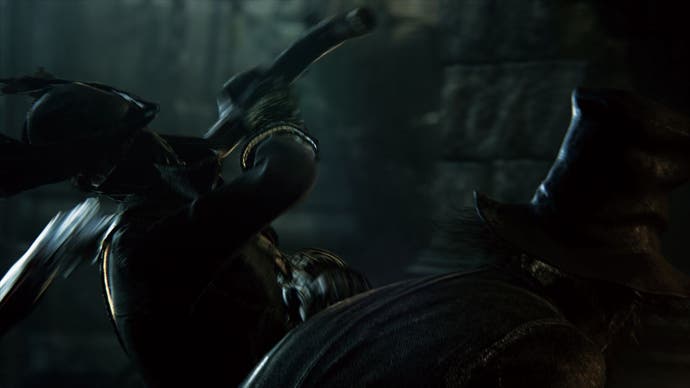
The added emphasis on violence extends to a play style that's another departure from what's gone before. "In Demon's Souls, you were equipped with a sword and a shield, so you could seek out an area and take a passive approach," explains Miyazaki. "But we're going to switch that up from passive to not aggressive so much, but more pro-active."
As such there's no shield in Bloodborne - instead, you're dual-wielding weapons that themselves have dual purposes. In your right hand is a saw that doubles up as a cleaver, transforming from one form to another with a flick of the wrist. The act of transformation is an attack in itself, suggesting that the shotgun in your left hand acts not as a cheap ranged weapon but as a perfect flourish to pepper off a counter-attack. The emphasis might be on the offensive, but it's been complemented by a deepening of the strategic options at hand.
Enemies, too, have more nuance. The diseased villagers that patrol the city have broader behaviour patterns - a mob of them may converge in a town square, working together in a hunt, before the familiar ring of a town bell will send them back out again on their own individual paths. It makes for a more organic, more emergent place to explore - enemies no longer simply spawn, it seems, but rather patrol the city according to their own internal logic. There's tragedy to that logic too, their behaviour part of some ritual the citizens of Yharnam are unwittingly locked into.
Unravelling how exactly that ritual relates to Yharnham's own history is of course one of the core pleasure's built into Bloodborne, and like Drangleic and Lordran before it this is a location steeped in enigmas. There are other, more straightforward enigmas surrounding Bloodborne right now, too. At one point you chance across an NPC locked in combat, and aiding them will grant you a little assistance when you face off against the area's boss, a hulking hybrid of Pan and a werewolf dubbed the Cleric Beast. As to how exactly the process of fighting alongside other players will work, Miyazaki's coy. "The key concept, or phrase, that we have right now is it's an open explorative community," is all he'll give away.
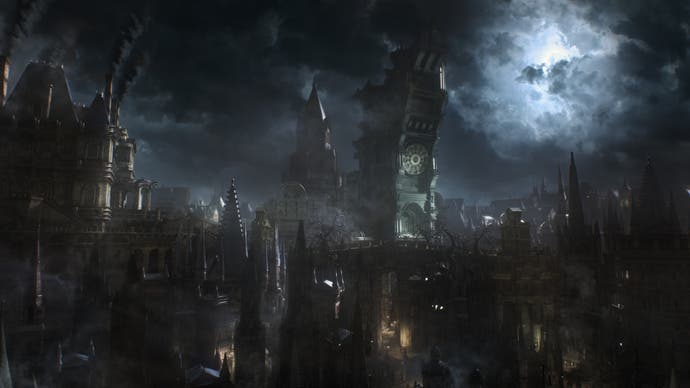
While many of Bloodborne's systems are taken directly from the Souls' series, some remain absent - for now at least. The demo runs without a UI, although each felled enemy sees a familiar whisp emerge from their corpse and enter the player's body, and thanks to invincibility being enabled for this demo, player death isn't encountered once. "The death penalty, and the concept, I don't want to make it such a heavy thing," ponders Miyazaki. "It's there, but I don't want it to cause undue stress."
Bloodborne's a fascinating proposition, then, a clear continuation of the themes established by Miyazaki while a departure that's relentlessly, almost impossibly grim. Is it all perhaps a little too dark? There's no cause for alarm, it seems, as Bloodborne will stay true to another of the director's other, more unsung traits.
"One of the core concepts that I've had, even with Dark Souls and Demon's Souls, is my mission and my goal is to make a very beautiful game," he says as the demo draws to a close. "I know a lot of people have a hard time believing it when I say those words, because that's not the first thing that comes to mind. I always believe that there is beauty in darkness. And so with Bloodborne, I feel like the darkness is darker, which means the beauty is going to rise - and you'll be able to really see that beauty out of the darkness."
If you need a little help completing the game, our Bloodborne walkthrough is live now.
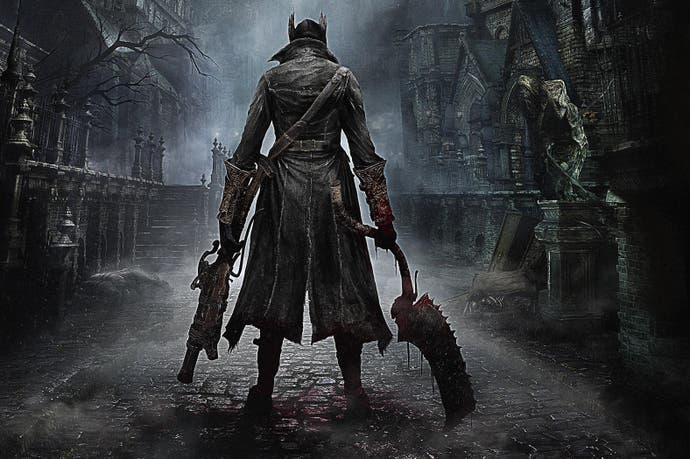



.png?width=291&height=164&fit=crop&quality=80&format=jpg&auto=webp)

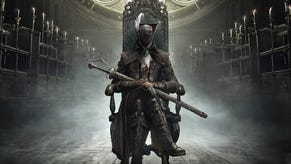

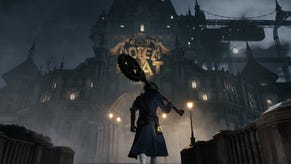
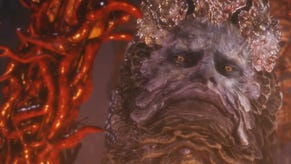

.png?width=291&height=164&fit=crop&quality=80&format=jpg&auto=webp)




.jpg?width=291&height=164&fit=crop&quality=80&format=jpg&auto=webp)
